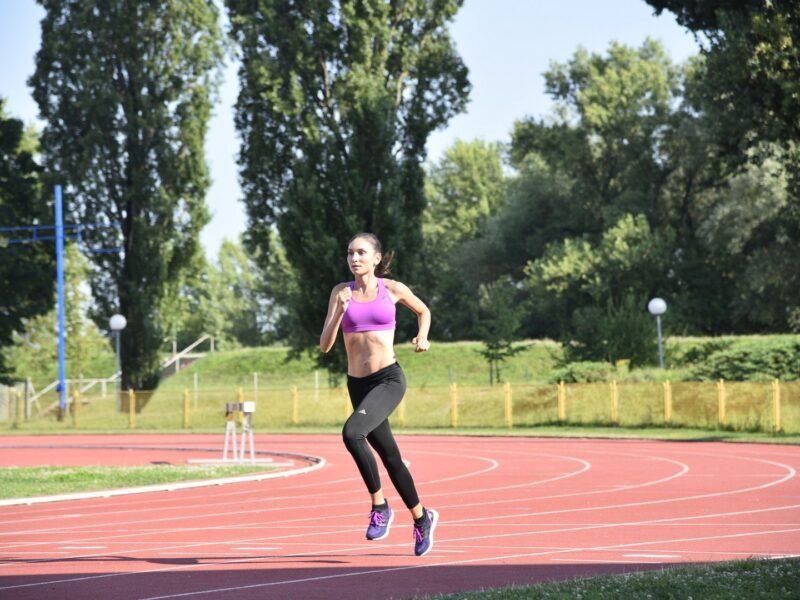Warm-up Routine Before Running (Training/Race)
Surely you have often heard that warming up before running is important.
How do you warm up? Do you have your own warm-up routine before running?
If you do not have one, it is important to develop one so that you can more easily prepare for the activities in the main part of your training or race.
This article will tell you how to develop your own warm-up routine and I will show you the routine I use before training or a race.
Key elements of a warm-up routine before running
A complete warm-up routine before running consists of two parts, the general and the specific.
It is important to understand that you will not include every element in your warm-up routine.
Gradually increase the intensity of your warm-up until you reach a level that is almost at the level of activity.
Warm-up has to be intensive enough to raise body temperature and speed up your breathing, but it cannot be at the level where it exhausts you too much.

The general part of a warm-up
The general part is an unavoidable part of your warm-up before training or a race and it includes:
- Aerobic activities of low intensity, such as walking or easy jogging
- Mobility exercises and dynamic stretches
The intensity and duration of your general warm-up depend on your physical condition.
On average your warm-up should last between 10 and 25 minutes.
Walking or easy jogging will increase your body temperature, and muscle temperature, and increase your heart rate and breathing which then leads to increased blood flow, improving the delivery of oxygen and nutrients to your muscles. You also reduce the risk of injury.
Mobility exercises and dynamic stretches are part of your warm-up routine before interval training, tempo runs, hill running, and every race.
This is how you prepare your joints, muscles, and connective tissue for activities that require more agility or endurance than everyday activities.
Tip
Your running pace does not matter; conserve your energy for the main part of your training or race.
The specific part of a warm-up
The specific part includes movements similar to the ones you will use in the main part of your training or race and those are:
- Running drills
- Strides
Running drills are part of a warm-up routine before interval training and shorter races (5K and 10K).
These drills improve communication between the brain and the muscles (neuromuscular activation), coordination, and balance and they prepare you for fast movements.
The drills also help improve your running technique, which then leads to an improved running economy and a reduced risk of injury.
Read more: Top 8 Running Drills To Improve Your Form (Video)
Running strides are part of a warm-up routine before interval training, tempo runs, and before every race.
Strides activate your fast muscle fibers and prepare you for more intensive training or race.
They also help you get used to the feeling of a faster run so that when you start doing your intervals, or you start a race, you will not shock your body.
Read more: What Are Running Strides And How To Do Them?
In the following part, I will explain the rules regarding warm-up routines before training or races so that you can develop your own routine.
I will also present all of my warm-up routines to use as examples.

Develop your warm-up routine
There is no definitive approach to warm-up that works for everyone. You need to develop your routine.
1. Adapt the warm-up routine to your fitness level
If you are a beginner when it comes to running you will need less time to reach the goal of warming up (increased body temperature, heart rate, and faster breathing), unlike more experienced runners.
The better shape you are in the longer you need to warm up.
2. Adapt the warm-up routine to the type of training or race
The shorter and more intensive the workout is the longer and more complex the warm-up should be.
For an easier and longer workout, you should have a shorter and simpler warm-up.
The same is true for races.
This is due to shorter races requiring more speed and being more intensive, putting a greater burden on your muscles as a result.
Tip
A marathon is long and the intensity is lower which means that beginners will do parts of their warm-up during the race itself. If the race is long enough your warm-up should be shorter so that you can conserve more energy.
When it comes to 5K races you don’t have enough time to warm up during the race. A complete warm-up routine is required so that you are ready for a faster pace from the start.
3. Adapt the warm-up routine to the weather
Your body has difficulty warming up at lower temperatures, which is why warm-up lasts longer in winter than in summer.
During colder times you should keep your body warm with warmer clothes.
Tip
Listen to your body and experiment with different exercises and exercise lengths so that you can learn what works best for you.
Read more: Warm-up Before Running [Ultimate Guide]

Warm-up routine before training
Each type of training requires a different warm-up routine, as I have already mentioned.
In the following text, I will present my warm-up routines, used before interval training, fartlek, tempo runs, hill running, and long runs.
Warm-up routine before interval training
Interval training is the type of training that includes intervals of high-intensity running with regular intervals of resting.
Breaks between intervals (standing still, walking, easy jogging) allow the body to rest, which then reduces the risk of injury and it reduces the stress caused by fast running.
All this makes it possible for a high-intensity run to last longer than it would if you ran without resting.
Benefits of interval training:
- Improves endurance and speed endurance
- Improves running economy
- Improves your body’s ability to dissolve lactic acid (raises lactate threshold)
- It burns up to three times as many calories as a long easy run
- Causes a so-called afterburn effect; after training your body continues spending additional energy to recover
- Develops a sense of pace; it becomes easier to control your pace at the beginning of a race when you are full of adrenaline
There are four types of interval training: short (up to 400m), medium (600-1200m), long (1500-3000m), and tempo intervals (broken tempo run).
The warm-up routine before short, medium, and long interval training includes:
- Easy jogging (5-15 minutes)
- Mobility exercises and dynamic stretches (5-10 minutes)
- Running drills (5-10 minutes)
- Strides – 2-3 x 60m (3-5 minutes)
Warm-up routines are differentiated only according to their length.
Before shorter interval training you should have a longer warm-up with a higher number of striders so that you are ready for the more intensive part of your training.
The first few intervals should be done a couple of seconds slower than intended to avoid early exhaustion.
Slowly increase your pace as you go from interval to interval.
It is important to end your training with the fastest interval in your pace range.
My warm-up routine before a medium interval training (10 x 1000m)
1. Easy jogging (15 minutes)
2. Mobility exercises and dynamic stretches (7 minutes)
3. Running drills – 2 x 40m ankling, 2 x 40m high knees, 2 x 40m butt kicks
4. Strides – 3 x 60m
The warm-up routine before tempo intervals is the same as the routine before tempo runs.
The two training types have the same purpose and are of equal intensity. Learn more in the following text.

Warm-up routine before tempo runs
A tempo run is a type of training that includes running at a pace that you can hold for about 60 minutes.
On average it lasts between 20 and 40 minutes and for more experienced runners it can last up to 60 minutes.
Benefits of tempo runs:
- Improves your body’s ability to dissolve lactic acid (raises lactate threshold)
- Improves endurance
- Improves running economy
- Increases pain tolerance
- Helps in controlling emotions when running becomes difficult
The warm-up routine before tempo runs includes:
- Easy jogging (5-15 minutes)
- Mobility exercises and dynamic stretches (5-10 minutes)
- Strides – 2-3 x 100m (5-8 minutes)
A tempo run is of medium intensity and as such it does not require running drills.
It is enough to do a couple of strides so that your body is prepared for running at the required pace.
Running too fast is a common mistake, so keep in mind that you have to control your pace.
My warm-up routine before a tempo run
1. Easy jogging (10 minutes)
2. Mobility exercises and dynamic stretches (5 minutes)
3. Strides – 2 x 100m
Warm-up routine before fartlek training
Fartlek is a type of training that consists of continuous running with alternating intervals of low and high speeds.
There are multiple variations of fartlek. A structured fartlek has predetermined lengths of slower and faster intervals, while a classic fartlek relies on feeling and inspiration.
Example of structured fartlek training (40 minutes total)
10 minutes of easy jogging (warm-up)
10 x alternating 1-minute intervals of easy jogging and 1-minute intervals of fast running
10 minutes of easy jogging
Benefits of fartlek training:
- Improves speed and endurance
- Burns up to three times as many calories as a continuous run
- Allows you to change pace more easily during a race
- Easily adaptable to your current state, you do not have to follow a predetermined pace (run according to how you feel)
The warm-up routine before a fartlek training session typically includes mobility exercises and dynamic stretching exercises, followed by an easy run of 5 to 15 minutes. Then, without stopping you should move on to the main part of your training; alternating slow and fast intervals.
My warm-up routine before fartlek training
1. Mobility exercises and dynamic stretches (5 minutes)
2. Easy jogging (10-15 minutes)
Read more: Fartlek Training: What Is And How To Do Fartlek?

Warm-up routine before hill running
Hill running is a type of training that includes running on a slope and is used to develop strength in runners.
Before you start hill running you should first learn how to run on uneven terrain.
Benefits of hill running:
- Develops speed (helps the development of fast muscle fibers), strength, and endurance
- Improves running economy
- Builds self-confidence and mental strength
- Reduces the risk of injury (lower restoring force for each step uphill)
- Burns more calories than running on flat surfaces
There are 3 types of hill running: short hill repeats, long hill repeats, and long hill runs.
Read more: 14 Amazing Hill Running Benefits for Runners
The warm-up routine before hill running includes:
- Easy jogging (5-15 minutes)
- Mobility exercises and dynamic stretches (5 minutes)
Warm up on flat terrains and avoid hills. If you are planning on doing short and long hill repeats the first repeat should be of lower intensity.
If you are planning on doing a long hill run then you should do several strides on flat terrain before you start.
My warm-up routine before short hill repeats (10 x 60 seconds hills)
1. Easy jogging (10 minutes)
2. Mobility exercises and dynamic stretches (5 minutes)
3. I run the first repeat at a lower intensity
Warm-up routine before a long run
A Long run is a type of training that includes a long run of lower-to-medium intensity.
The day after the long run you should do an easier type of training or relax completely due to the exhaustion that follows.
Benefits of the long run:
- Develops endurance
- Teaches the body to use fat as an energy source
- Builds self-confidence and mental strength (helps the body and mind to adapt to longer distances)
The warm-up routine before a long run involves mobility exercises, dynamic stretching exercises, and a light jog.
Run the first 5 or 10 minutes at a slower pace and gradually increase the speed until you reach your goal pace.
My warm-up routine before long run
1. Mobility exercises and dynamic stretches (5 minutes)
2. Easy jogging for the first 10 minutes and then I gradually increase the pace until I reach the target pace.

Warm-up routine before races
Races of different distances require different warm-up routines.
Just like with warm-ups before training, warm-ups before races are also inversely proportional to the races themselves.
The shorter the race the longer and more complex your warm-up should be.
If the race is long, for example, a half marathon or a marathon, the warm-up is shorter and simpler.
If you have your warm-up routine you will reduce the stress you feel before the race.
In this way, you will be focused on what is already known and will be able to mentally prepare for the exertion that awaits you.
Tip
During training you should see what works for you. A race is no place for experiments; instead you should use warm-up routines similar to the ones you’ve used during training.
Finish your warm-up as close to the start of the race as possible.
The effects of warming up are temporary – Research has shown that after 45 minutes of rest, you lose the positive effects of warming up because muscle temperature returns to its original level.
Tip
When you are preparing for a particular race think of where, how, and when you will warm up.
In local races, you will have plenty of space near the starting line and will be able to perform your whole warm-up routine uninterrupted.
In larger races, in which you have to get to your starting zone early, it will be more difficult to find space for a complete warm-up. This is why it is important to plan your warm-up in advance and to maintain temperature by doing running drills in place.
You should also maintain your temperature with clothes. Bring an older tracksuit, shirt, gloves, or a hat to the start of the race. Something that will be easy to remove once the race starts and something you won’t really miss if you accidentally lose it.
Warm-up routine before 5K and 10K races
5K and 10K races are of medium length and are relatively short.
As a result, you should be prepared for high intensity from the very beginning of the race.
The warm-up routine before 5K and 10K races for advanced runners is the same as the warm-up routine before interval training and it includes:
- Easy jogging (10-15 minutes)
- Mobility exercises and dynamic stretches (5-10 minutes)
- Running drills (5-10 minutes)
- Strides – 3-4 x 60m (5-6 minutes)
Warm-up routine before 5K and 10K races for beginners includes:
- Easy jogging (5-10 minutes)
- Mobility exercises and dynamic stretches (5-10 minutes)
- Strides – 2-3 x 60m (3-4 minutes)
My warm-up routine before 5K and 10K races
1. Easy jogging (10-15 minutes)
2. Mobility exercises and dynamic stretches (5-10 minutes)
3. Running drills – 2 x 40m ankling, 2 x 40m high knees, 2 x 40m butt kicks
4. Strides – 3 x 60m

Warm-up routine before a half marathon
A half marathon is a race that is quite long but still relatively fast for advanced runners.
If your goal is to run your first half marathon or just want to enjoy the race, then the intensity of the race is lower and the whole warm-up is not required.
The warm-up routine before a half marathon for advanced runners includes:
- Easy jogging (10-15 minutes)
- Mobility exercises and dynamic stretches (5-10 minutes)
- Running drills (5-10 minutes)
- Strides – 2-3 x 100m (5-8 minutes)
The warm-up routine before a half marathon for beginners includes:
- Easy jogging (5-10 minutes)
- Mobility exercises and dynamic stretches (5-10 minutes)
- Strides – 1-2 x 100m (1-3 minutes)
My warm-up routine before a half marathon
1. Easy jogging (10 minutes)
2. Mobility exercises and dynamic stretches (5-7 minutes)
3. Running drills – 2 x 40m ankling, 2 x 40m high knees
4. Strides – 3 x 100m
Warm-up routine before a marathon
A marathon is a race that, for most people, lasts longer than 3 hours and as a result, you need to adapt your warm-up routine to your abilities to enter the race fresh.
Your warm-up should be light and easy.
Be careful not to run for too long, or too fast so that you don’t spend your glycogen reserves and enter the race exhausted.
The warm-up routine before a marathon for advanced runners includes:
- Easy jogging (5-10 minutes)
- Mobility exercises and dynamic stretches (5-10 minutes)
- Strides – 1-2 x 100m (1-3 minutes)
The warm-up routine before a marathon for beginners includes:
- Easy jogging (5 minutes)
- Mobility exercises and dynamic stretches (5-10 minutes)
For beginners, easy jogging and mobility exercises and dynamic stretches are enough and they can be done as you wait for the race to begin at your starting zone.
If your goal is simply to finish a marathon and to have a good time, then you should use the first few miles of the race as part of your warm-up.
Then gradually accelerate the pace until you reach the one you will run to the end of the race.
My warm-up routine before a marathon
1. Easy jogging (5-10 minutes)
2. Mobility exercises and dynamic stretches (5-7 minutes)
3. Strides – 2 x 100m

Matea Matošević
Hi, I’m Matea! I’m an Olympic Marathon Runner, founder, and writer behind OLYRUN.com. On this site, I provide help in the form of my knowledge and experience to all who love running and active living. Read more…
